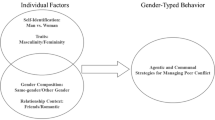Abstract
Gender differences in relationship quality, conflict perceptions, reported conflict strategy use, and self-monitoring orientations were examined in a sample of undergraduates. It was predicted that males and high self-monitoring individuals would see their relationships as less intimate, themselves as less committed, and would endorse more frequent use of uncooperative and avoidant strategies. Participants (n=124) completed the following: a measure of conflict perceptions; a Conflict Strategy Scale measuring frequency of Cooperative, Uncooperative, and Denial-Avoidant strategies; and Snyder’s Self-Monitoring Scale. Compared to females, males scored higher in self-monitoring, saw friendships as less intimate and stable, saw their conflicts as more stable, and endorsed more frequent use of Denial-Avoidant strategies. Masculine orientations to conflict reflected increased self-presentational concerns and perceptions that minimized the personal relevance of conflict.
Similar content being viewed by others
References
Aries, E. J., & Johnson, F. L. (1983). Close friendship in adulthood: Conversational content between same-sex friends.Sex Roles, 9, 1183–1195.
Aukett, R., Richie, J., & Mill, K. (1988). Gender differences in friendship patterns.Sex Roles, 19, 57–66.
Barth, R. J. & Kinder, B. N. (1988). A theoretical analysis of sex differences in same-sex friendships.Sex Roles, 19, 349–363.
Bell, R. R. (1981).Worlds of friendship. Beverly Hills: Sage.
Betz, N. E. (1987). Use of discriminant analysis in counseling psychology research.Journal of Counseling Psychology, 34, 393–403.
Caldwell, M. A., & Peplau, L. A. (1982). Sex differences in same-sex friendship.Sex Roles, 8, 721–732.
Chainin, M. N., & Schneer, J. A. (1984). A study of the relationship between Jungian personality dimensions and conflict-handling behavior.Human Relations, 37, 863–879.
Cody, M. J., & McLaughlin, M. L. (1980). Perceptions of compliance-gaining situations: A dimensional analysis.Communication Monographs, 47, 132–148.
Cowan, G., Dunkard, J., & MacGavin, L. (1984). The effects of target, age, and gender on use of power strategies.Journal of Personality and Social Psychology, 47, 1391–1398.
Falbo, T., & Peplau, L. A. (1980). Power strategies in intimate relationships.Journal of Personality and Social Psychology, 38, 618–628.
Fincham, F. D. & O’Leary, K. D. (1983). Causal inferences for spouse behavior in maritally distressed and nondistressed couples.Journal of Social and Clinical Psychology, 1, 42–57.
Fischer, J. & Narus, L. (1981). Sex roles and intimacy in same sex and other sex relationships.Psychology of Women Quarterly, 5, 444–455.
Fitzpatrick, M.A., & Winke, J. (1979). You always hurt the one you love: Strategies and tactics in interpersonal conflict.Communication Quarterly, 27, 3–11.
Haase, R. F. & Ellis, M. V. (1987). Multivariate analysis of variance.Journal of Counseling Psychology, 34, 404–413.
Haferkamp, C. (1987). Conflict among clinic couples: Self-monitoring, causal attributions, and resolution strategies. (Doctoral dissertation, Ball State University, 1987).University Microfilms No. 82-27, 163.
Holtzworth-Munroe, A., & Jacobson, N. S. (1985). Causal attributions of married couples: When do they search for causes? What do they conclude when they do?Journal of Personality and Social Psychology, 48, 1398–1412.
Howard, J. A., Blumstein, P., & Schwartz, P. (1986). Sex, power, and influence tactics in intimate relationships.Journal of Personality and Social Psychology, 51, 102–109.
Jacobson, N. S., McDonald, D. W., Follette, W. C., & Berley, R. A. (1985). Attributional processes in distressed and nondistressed married couples.Cognitive Therapy and Research, 9, 35–50.
Johnson, P. B. (1978). Women and interpersonal power. In I. H. Frieze, J. E. Parsons, P. B. Johnson, D. N. Ruble, & G. L. Zellman (Eds.),Women and sex roles: A social psychological perspective (pp. 301–320). New York: Norton.
Madden, M. E. (1988). Influence strategies in nonromantic and romantic friendships. Paper presented at the American Psychological Association convention, Atlanta, Georgia.
Rosenbluth, S. (1990). Intimacy: Women’s experiences of same-sex and cross-sex couples. Paper presented at the American Psychological Association convention, Boston, MA.
Rubin, Z., Peplau, L. A., & Hill, C. T. (1981). Loving and leaving: Sex differences in romantic attachments.Sex Roles, 7, 821–835.
Sapadin, L. A. (1988). Friendship and gender: Perspectives of professional men and women.Journal of Social and Personal Relationships, 5, 387–403.
Sillars, A. L. (1980). Attributions and communication in roommate conflicts.Communication Monographs, 47, 180–200.
Sillars, A. L. (1985). Interpersonal perception in relationships. In W. J. Ickes (Ed.),Compatible and incompatible relationships. New York: Springer Verlag.
Snyder, M. (1974). The self-monitoring of expressive behavior.Journal of Personality and Social Psychology, 30, 526–537.
Snyder, M. (1987).Public appearances, private realities: The psychology of self-monitoring. New York: W. H. Freeman and Co.
Snyder, M., Berscheid, E., & Glick, P. (1985). Focusing on the interior and exterior.Journal of Personality and Social Psychology, 50, 821–835.
Snyder, M., Gangestad, S., & Simpson, J.A. (1983). Choosing friends as activity partners: The role of self-monitoring.Journal of Personality and Social Psychology, 50, 821–835.
Snyder, M., & Gangestad, S. J. (1986). On the nature of self-monitoring: Matters of assessment, matters of validity.Journal of Personality and Social Psychology, 51, 125–139.
Snyder, M., & Simpson, J. (1984). Self-monitoring and dating relationships.Journal of Personality and Social Psychology, 47, 1281–1291.
Synder, M., Simpson, J.A., & Gangestad, S. (1986). Personality and sexual relations.Journal of Personality and Social Psychology, 51, 181–190.
Thompson, S. E., & Kelley, H. H. (1981). Judgments of responsibility for activities in close relationships.Journal of Personality and Social Psychology, 41, 469–477.
Weiss, L., & Lowenthal, M. F. (1975).Four stages of life. San Francisco: Jossey-Bass.
Wright, P. H. (1982). Men’s friendships, women’s friendships and the alleged inferiority of the latter.Sex Roles, 8, 1–20.
Author information
Authors and Affiliations
Rights and permissions
About this article
Cite this article
Haferkamp, C.J. Orientations to conflict: Gender, attributions, resolution strategies, and self-monitoring. Current Psychology 10, 227–240 (1991). https://doi.org/10.1007/BF02686895
Accepted:
Issue Date:
DOI: https://doi.org/10.1007/BF02686895




